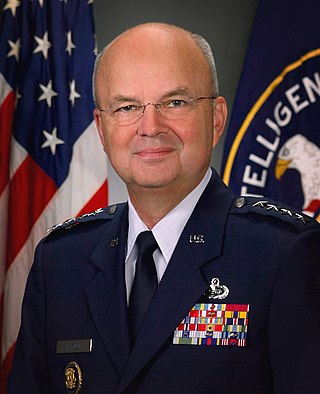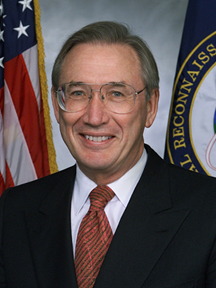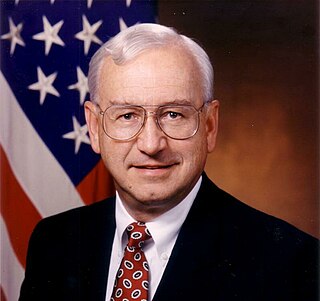Related Research Articles
Open-source intelligence (OSINT) is the collection and analysis of data gathered from open sources to produce actionable intelligence. OSINT is primarily used in national security, law enforcement, and business intelligence functions and is of value to analysts who use non-sensitive intelligence in answering classified, unclassified, or proprietary intelligence requirements across the previous intelligence disciplines.

William Oliver Studeman is a retired admiral of the United States Navy and former deputy director of the Central Intelligence Agency, with two extended periods as acting Director of Central Intelligence. As deputy director of Central Intelligence, he served in the administrations of George H. W. Bush and Bill Clinton under three directors of Central Intelligence, Robert Gates, R. James Woolsey Jr., and John M. Deutch. Studeman retired from the navy in 1995 after almost 35 years of service. Between 1988 and 1992 he was director of the National Security Agency; he was the Director of Naval Intelligence, from September 1985 to July 1988.

Norman Ralph "Norm" Augustine is a U.S. aerospace businessman who served as United States Under Secretary of the Army from 1975 to 1977. Augustine served as chairman and CEO of the Lockheed Martin Corporation. He was chairman of the Review of United States Human Space Flight Plans Committee.
In-Q-Tel (IQT), formerly Peleus and In-Q-It, is an American not-for-profit venture capital firm based in Arlington, Virginia. It invests in high-tech companies to keep the Central Intelligence Agency, and other intelligence agencies, equipped with the latest in information technology in support of United States intelligence capability. The name "In-Q-Tel" is an intentional reference to Q, the fictional inventor who supplies technology to James Bond.

The National Intelligence Distinguished Service Medal (NIDSM) is a decoration awarded for service to the United States Intelligence Community. The decoration is awarded to any member or contributor to the National Intelligence Community, either civilian or military, who distinguishes themselves by meritorious actions to the betterment of national security in the United States of America, through sustained and selfless service of the highest order.

William Joseph Burns is an American diplomat who has served as director of the Central Intelligence Agency (CIA) in the Biden administration since March 19, 2021. He previously served as U.S. deputy secretary of state from 2011 to 2014; in 2009 he served as acting secretary of state for a day prior to the Senate confirmation of Hillary Clinton. Burns retired from the U.S. Foreign Service in 2014 after a 32-year diplomatic career. From 2014 to 2021, he served as president of the Carnegie Endowment for International Peace.

Michael Vincent Hayden is a retired United States Air Force four-star general and former Director of the National Security Agency, Principal Deputy Director of National Intelligence, and Director of the Central Intelligence Agency. He also serves as a professor at the George Mason University - Schar School of Policy and Government. Hayden currently co-chairs the Bipartisan Policy Center's Electric Grid Cyber Security Initiative. In 2017, Hayden became a national security analyst for CNN.

Donald MacLean Kerr, Jr. served as the Principal Deputy Director of National Intelligence from 2007 to 2009. He was confirmed by the U.S. Senate on Thursday, October 4, 2007. In March 2009, he received the National Intelligence Distinguished Service Medal.

John Owen Brennan is a former American intelligence officer who served as the Director of the Central Intelligence Agency (CIA) from March 2013 to January 2017. He served as chief counterterrorism advisor to U.S. President Barack Obama, with the title Deputy National Security Advisor for Homeland Security and Counterterrorism, and Assistant to the President. Previously, he advised Obama on foreign policy and intelligence issues during the 2008 election campaign and presidential transition.

Scott F. Large is an American intelligence officer who served as the sixteenth Director of the National Reconnaissance Office from 2007 to 2009. He previously served as the Principal Deputy Director of the National Reconnaissance Office from April to October 2007, and as the Central Intelligence Agency's Associate Deputy Director for Science and Technology.

Paul Allan Schneider is a former United States Deputy Secretary of Homeland Security. He had previously served as the Under Secretary of Homeland Security for Management. He was responsible for all the department's budget, appropriations, expenditure of funds, accounting and finance; procurement; human resources and personnel; information technology systems; facilities, property, equipment, and other material resources; and identification and tracking of performance measurements.

The Directorate of Science & Technology (DS&T) is the branch of the United States Central Intelligence Agency (CIA) tasked with collecting and analyzing information through technological means and developing technical systems in order to advance the CIA’s intelligence gathering.
The Intelligence Medal of Merit is awarded by the Central Intelligence Agency for performance of especially meritorious service or for achievement conspicuously above normal duties.

Dennis D. Fitzgerald was the first Principal Deputy Director of the National Reconnaissance Office

Letitia A. Long served as a civilian in the U.S. Navy and the Intelligence Community between 1978 and 2014, retiring as the fifth Director the National Geospatial-Intelligence Agency, and the first woman to lead a major U.S. intelligence agency, in October 2014. She currently is the Chairman of the Board for the Intelligence and National Security Alliance (INSA).

Paul Garrett Kaminski is a technologist and former U.S. government official, best known for his leading role in the development of stealth aircraft.

Stephen Joseph Lukasik was an American physicist who served in multiple high-level defense and scientific related positions for advancing the technologies and techniques for national defense and the detection and control of diverse types of weapons of mass destruction, especially nuclear devices. He was the second longest serving Director of DARPA - the Defense Advanced Research Projects Agency – during which numerous new technologies including packet and internet protocols were developed. He was also the first chief scientist of the Federal Communications Commission where he created its Office of Science and Technology and which facilitated the commercial deployment of new technology that included spread spectrum technology.
Mark E. Kelton is a former senior executive of the Central Intelligence Agency, concluding his career with the position of Deputy Director of the National Clandestine Service for Counterintelligence (DDNCS/CI). He is currently an adjunct assistant professor at Georgetown University, and Director of Threat Insider Solutions at Cipher Systems, LLC.

Joanne O'Rourke Isham is an espionage and security expert from the United States. She is a former member of the Central Intelligence Agency (CIA) and currently involved in geospatial intelligence.

Leo A. Hazlewood was Director of National Photographic Interpretation Center from February 1991 – September 1993), and Deputy Director of National Imagery and Mapping Agency from July 1997 – January 2000. He also served as Deputy Director of Operations at National Imagery and Mapping Agency.
References
Citations
- 1 2 Synergy 2000.
- 1 2 3 Bloomberg 2016.
- 1 2 Society of Women Engineers 1998, p. 2.
- ↑ Vankin 2001.
- 1 2 Ackerman 1996.
- 1 2 MIT 2004.
- 1 2 National Science Foundation 2016.
- ↑ Women in Technology International Hall of Fame 2010.
- ↑ White House 2012.
- ↑ "Ruth David". National Academy of Engineering. Retrieved October 25, 2022.
Bibliography
- Ackerman, Robert K. (April 1996). "Vital Intelligence Technologies Converge on Information Systems". Signal Magazine . Fairfax, Virginia: Armed Forces Communications and Electronics Association. Archived from the original on February 20, 1999.
{{cite journal}}: CS1 maint: unfit URL (link) - Vankin, Jonathan (March 29, 2001). "The Spy Who Funded Me". San Jose, California: Metroactive. Archived from the original on March 13, 2015. Retrieved 18 April 2016.
- "Dr. Ruth David". Sherman Oaks, California: Women in Technology International Hall of Fame. 2010. Archived from the original on June 15, 2011. Retrieved 18 April 2016.
- "Dr. Ruth A. David". Cambridge, Massachusetts: Massachusetts Institute of Technology. 2004. Archived from the original on August 17, 2004. Retrieved 18 April 2016.
- "Dr. Ruth A. David". Irvine, California: Synergy Inc. 2000. Archived from the original on December 19, 2000. Retrieved 18 April 2016.
- "Our guest speaker on May 19th will be: Dr. Ruth A. David, Deputy Director for Science and Technology for the Central Intelligence Agency" (PDF). National Career Centers Newsletter. Philadelphia, Pennsylvania: Society of Women Engineers Philadelphia Section. May 1998. Retrieved 18 April 2016.
- "President Obama Announces More Key Administration Posts". whitehouse.gov . Washington, D.C. December 20, 2012. Archived from the original on February 16, 2017. Retrieved 18 April 2016– via National Archives.
- "Ruth David". Arlington, Virginia: National Science Foundation. 2016. Archived from the original on April 18, 2016. Retrieved 18 April 2016.
- "Ruth A. David Ph.D." New York City, New York: Bloomberg. 2016. Archived from the original on April 18, 2016. Retrieved 18 April 2016.